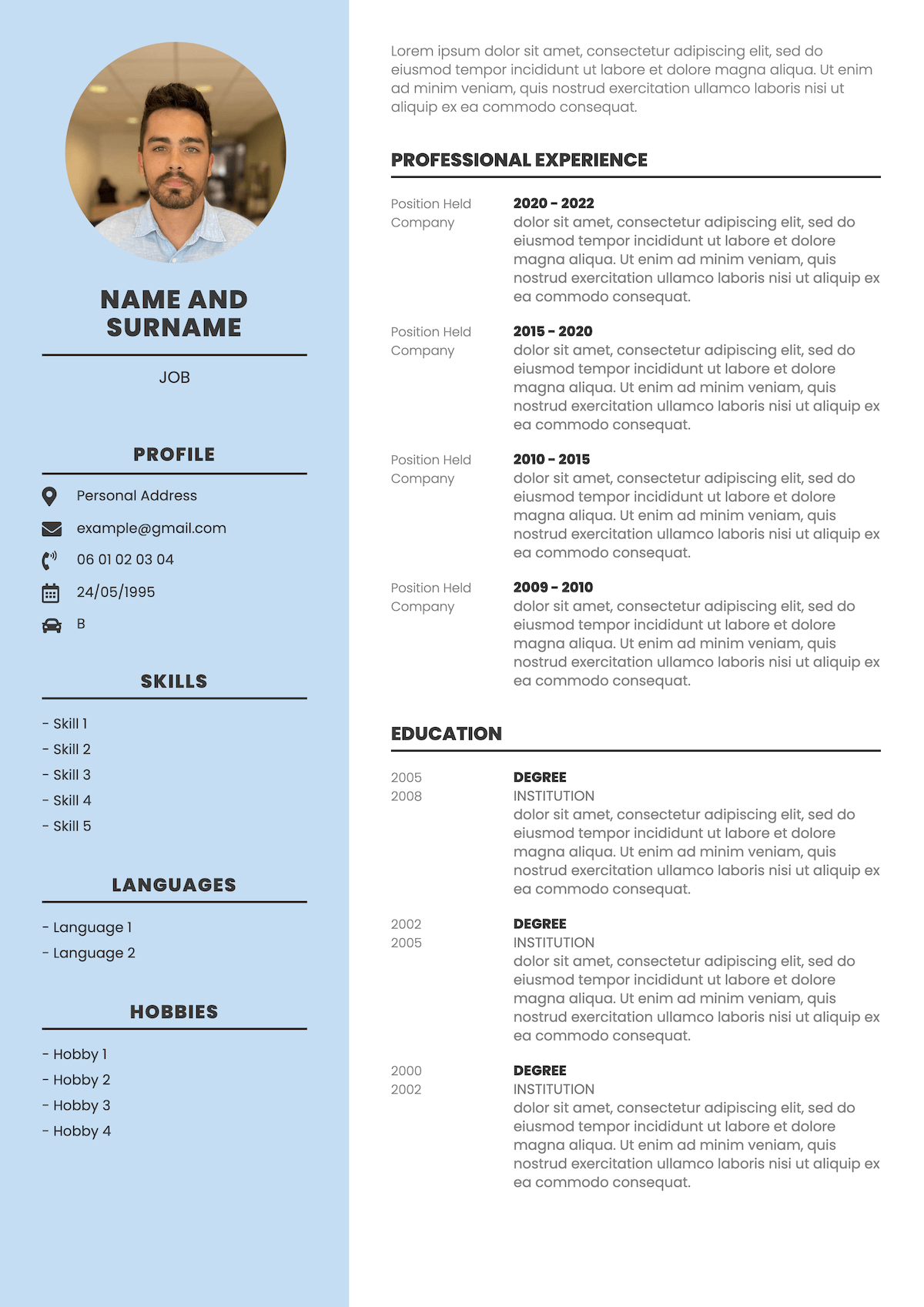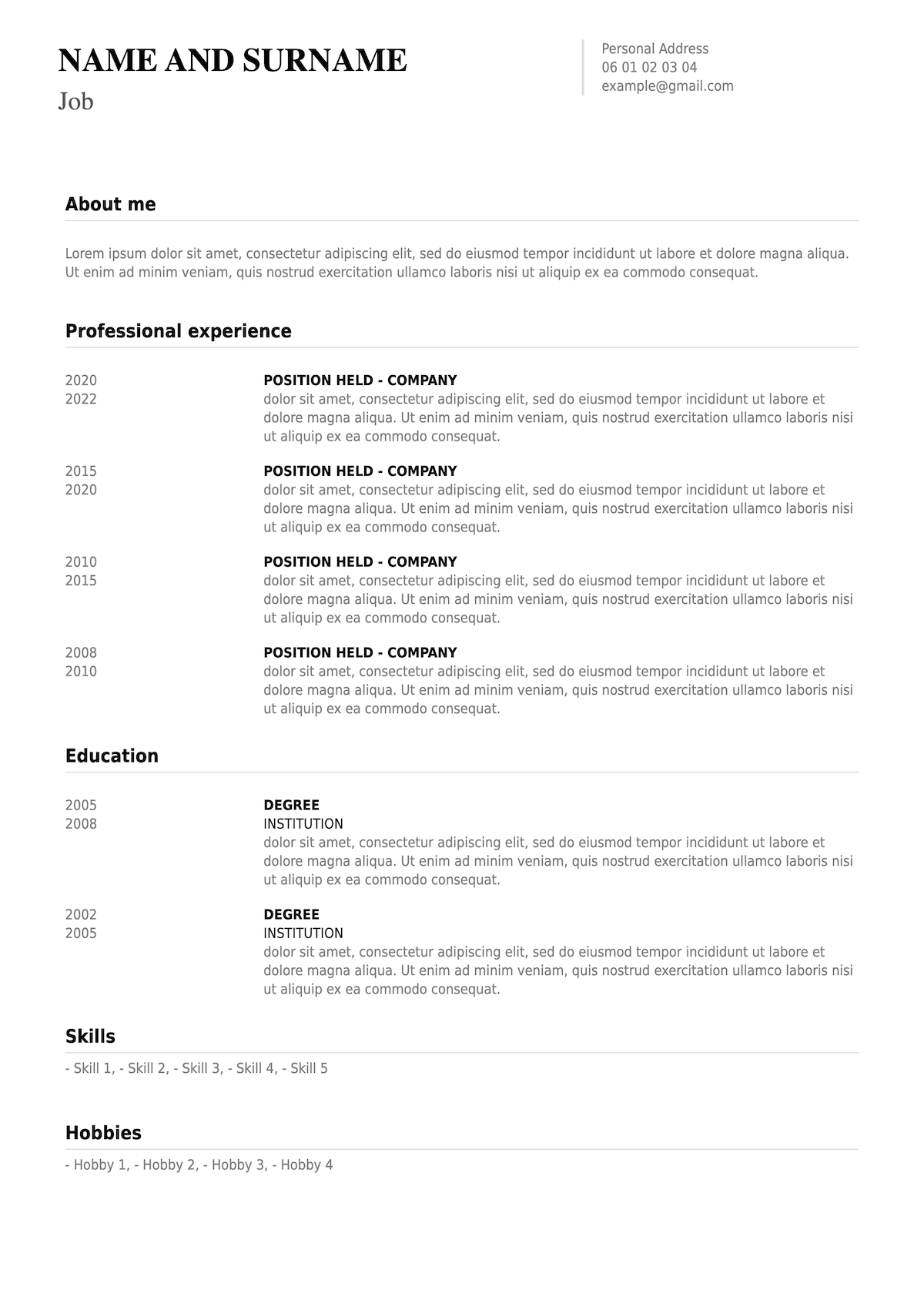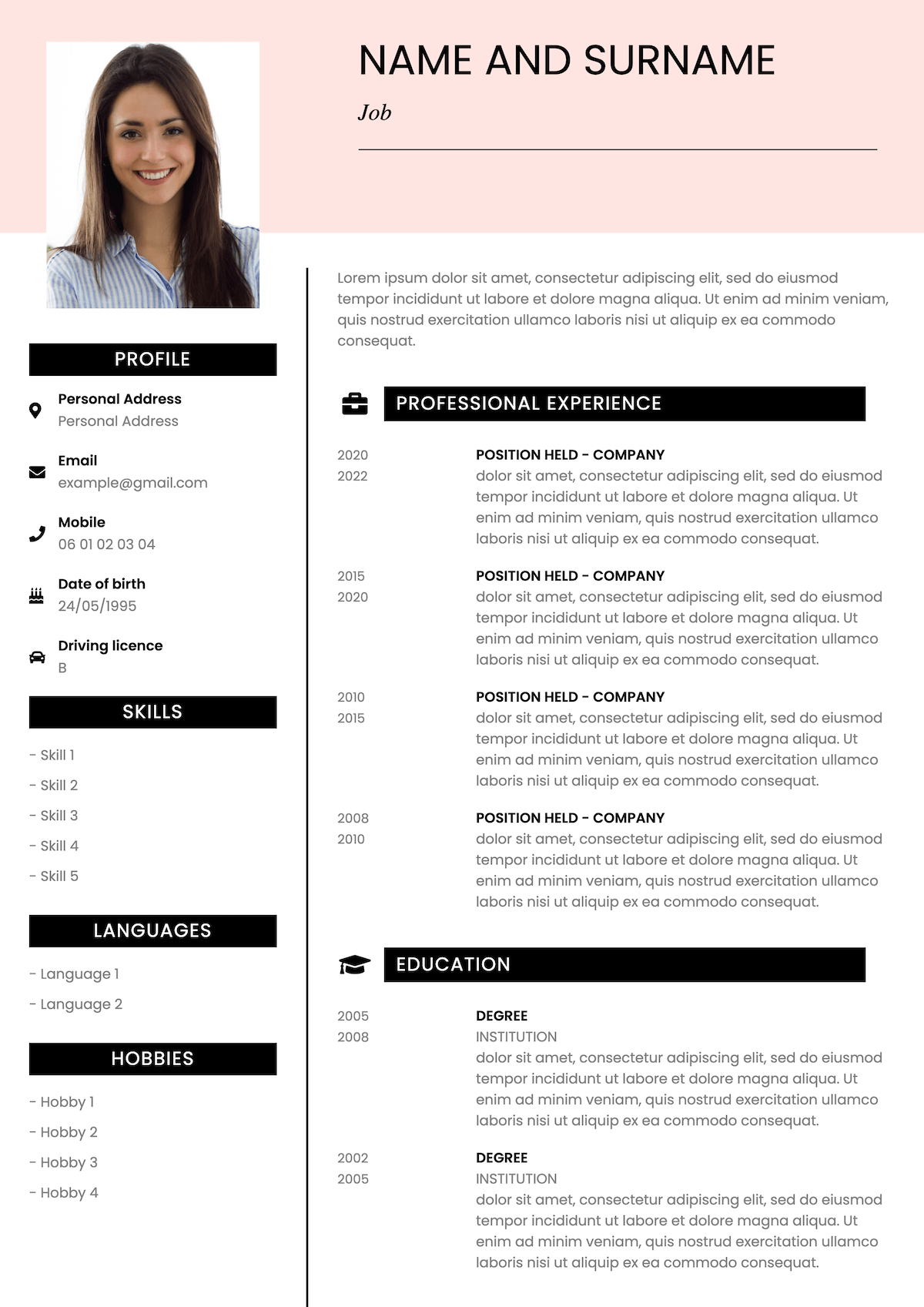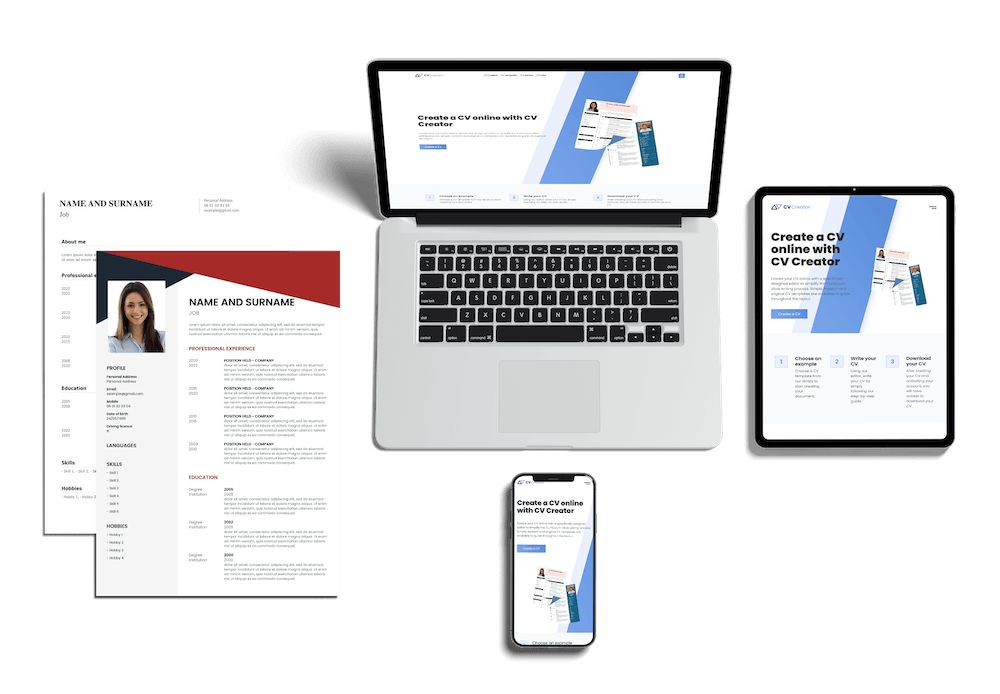Tips to write a CV
Writing a CV can sometimes seem like walking on eggshells! So many mistakes to avoid to create a winning CV. Keep reading if you want to benefit from great tips for your CV.
Create your CV now
Choose a template CV and create your own online
Want to see more CV templates?

You’ll often hear, the “best form of offense is defense”. The same can be said for your CV. Avoid many simple mistakes and you will be sitting at the top of the pile.
So if you are looking for your dream job, you need a CV that will impress the recruiters. As every CV is different, it has different challenges to overcome. From the format to the layout, every aspect of a CV can be scrutinised.
To make sure you can avoid making the mistakes the majority of candidates make, we have made a list of 21 CV tips just for you.
In a rush to build your CV? Don’t have time to go through the entire blog and need a great CV in 5 minutes? Give our CV Creator a go. With more than 20 tailored CV’s to choose from, you will be spoilt for choice.
So if you are short of time, you can create your CV here.
Research
Tip 1. Always do your research before starting your CV. Your CV is always a response to a need from a recruiter. To write a CV without conducting research is a waste of time.
A CV requires a top-down approach. Start by finding all the necessary skills and experience the job role you want requires. Do this by looking at many job adverts. Make a list of all the keywords that come out time and time again. Highlight the skill which employers are seeking the most.
Now that you have compiled a list of keywords, you have a workable framework. This is the most time-consuming part of creating a CV. But it is also the most rewarding.
Font
Tip 2. Many candidates use a font unknown to employers. This is a major red flag. The aim of your CV is to make it easy to read for the reader. Do not use a complicated font for your Curriculum Vitae. It is common for a CV to use one of these fonts:
- Calibri
- Arial
- Helvetica (the most used font in the world)
- Times New Roman
- Verdana
Only apply another type if it is specifically requested by the employer. It is of no use to take a risk with the choice of font. Remember, you are trying to impress an employer with your credentials.
For a full breakdown on the CV font to use, click here.
CV Colour
Tip 3. Every candidate wants their CV to stand out. However, it needs to be for the right reasons. Therefore, avoid flashy colours as a background colour. They will only distract the reader.
Use a conventional background for your CV. The most commonly used is white. Only add other colours to break up segments. There should be no more than 3 different colours on a CV. Just like a Design CV. Ensure the colours remain professional throughout.
Add Bullet Points
Tip 4. A great way to break up a big paragraph is with bullet points. Employers love bullet points. They are quick to identify and read. In addition, they summarise the key points you want to make. The reader can spend less time on your CV and identify more key information.
No one wants to read a page which is not structured properly, hence why CV structure is crucial.
Make sure the bullet points summarise your ideas clearly. The employer is more likely to keep them in mind.
Use a Reverse Chronological CV Layout
Tip 5. The most common type of CV is the Chronological CV. It focuses on your most recent achievements. It makes little sense to start your CV with experiences from 10 years ago.
By stating your most recent experiences first, it gives the reader an idea of where you are now in your career.
Furthermore, this structure is just as viable for career changes as it is for graduates. If you have just left university, list your academic results in reverse order.
Clarify all Gaps on your CV
Tip 6. An employer will often see CV gaps as a major red flag. Especially if they are left unexplained. Do not shy away from gaps on your CV. A gap on your CV can happen for many reasons, sometimes out of your control. Whilst a recruiter does not need to know the finer details, it must be stated briefly why.
If you have been unable to find work for a long period of time, focus on skills or activities outside of work. Mention volunteer work or an eagerness to learn new skills.
Insert a Personal Statement in your CV
Tip 7. A crucial element for any CV. A personal statement is compulsory in the United Kingdom. It is a short paragraph at the start of your CV.
This makes it even more important as it is the first section a recruiter reads. It gives you the chance to outline your past achievements, your skills and ambitions within a firm.
Keep in mind, CV personal profile should be longer than 5 sentences. Expect to spend as much time on this section as your work experience.
Use a Professional Email Address
Tip 8. In the UK and the USA, recruiters reject 24% and 31% of CV’s due to the email address. An unprofessional email address can mean your CV gets rejected before it is even read.
A CV is a professional document, every aspect must respect this standard.
It’s very simple. Use your full name and a credible domain name as your email address on a CV. Do not use an email such as sexyJohn111@gmail.com. All efforts will be in vain for one moment of inattention.
Incorporate a Skills Section
Tip 9. A great section to add to any CV, a key skills section can be a great way to impress a recruiter. Often placed just below your personal statement, it focuses on your most important skills.
Tailor the section to the keywords you have found in the job advert. The aim is not to list every skill you have but those most relevant. Enlist the skills with bullet points. Each skill should represent one bullet point.
Finally, make sure these skills are demonstrated with tangible achievements throughout your CV.
Customise your CV for Every Application
Tip 10. A mistake made by many candidates. Once a CV is finalised, the candidate sends the same one to 100 job adverts. Do not take this approach.
You are more likely to get more interview calls by sending 10 tailored CV’s. Every job advert is different. This means every application sent is different as well. Assess the job description. Focus on the keywords in the job description and apply these throughout your CV and Cover Letter.
Use the core skills sections as the framework for the rest of your CV.
Easy to Read Sections
Tip 11. A CV must be clear and concise. Such a CV will be visible without having to read a single word.
There is nothing worse than huge sections for a reader. It immediately means it will be a chore to read it through. Break up the text by including appropriate spacing throughout. Key information must be as accessible as possible. Do not make reading your CV a challenge for a recruiter.
Keep in mind, they filter through hundreds of CV’s everyday. They may not even read a CV with clunky paragraphs. If they use ATS software to filter CVs, your CV does not stand a chance.
Be Honest
Tip 12. Do not feel tempted to lie on your CV to boost your credentials. A study found that more than 30% of people lie on their CV every year. Doing this may get you past the initial stage and land an interview. However, an interviewer will require little to find out that you have been lying.
What’s more, even if an employer does not find out directly, references will be called for feedback. It is likely that doubts will start to creep in talking to past employers.
The best way to build your CV is with honesty. If you feel you are struggling, develop skills further or seek external guidance.
Add Numbers to Your CV
Tip 13. The most tangible way to demonstrate results is through figures. Employers love CV’s with key figures and results. It provides a defined achievement for the reader to analyse.
Most applications will not include figures. Instead they will focus on their soft skills. These skills are needed but are very hard to measure. A CV must combine soft and hard skills.
Add your figures to maximise their effect. The best place to add them on your CV is within your work experiences. Within each role occupied, demonstrate the results you have achieved.
Here a few examples:
- Helped increase the product margin from 16% to 19% through negotiations with raw materials suppliers.
- Managed a team of 6 collaborators as Project Manager
- Steered a 4 departments through entire project
Proofread your CV before sending
Tip 14. Proofread your CV before emailing or sending it to the employer. It will only take 15 minutes. It can also be the difference between you getting an interview or not. In America, 68% of CVs with spelling mistakes are rejected. In the United Kingdom, the figure is less harsh with 57%.
Spelling mistakes show a lack of professionalism and credibility. It sends a message that you are happy to send unfinished work to be valued. It can be very frustrating to send a CV you have worked tirelessly for, to be ruined for a spelling mistake. If you are unsure, ask a friend or a relative to proofread it for you. Alternatively, use a software to analyse for mistakes.
CV Document Name
Tip 15. Small details matter. They compound to create a great product or CV. Often overlooked by many applicants, your CV name should be professional.
For example, a CV file should read: David Smith Asset Manager Application.
Do not name the file: Dave applying to manage money.
If unsure, use the exact title of the job advert with your full name.
Send in PDF or Word Format
Tip 16. The two most common CV formats are Word and PDF. Send your CV using one of these two formats. They are easy to open and you do not need to stress whether an employer can open the file. There is little use to send an application if the recruiter cannot open it.
These formats also provide confidence. A PDF CV will never end up in a spam mail. It has been verified for viruses. A Word CV must be more vigilant. If your email address has a history of sending spam mail, it may never reach the reader.
Avoid Informal Language
Tip 17. A CV is a professional document. The language used by a candidate must reflect the industry. Specific vocabulary for the field is expected. As mentioned in other tips, the core of your CV is based around the keywords of the job advert.
Maximum CV Length
Tip 18. Avoid writing a CV which exceeds one A4 page. Keep in mind, the reader does not want to read your autobiography. You are replying to his needs. Only pick the parts of your skills which will meet the criteria.
Therefore, be selective during this process. Ensure every word you add increases the chance of success. If your CV is 2 pages long, apply the pareto principle. You will find there are often many ways to decrease the number of words diligently.
Professional Page Transitions
Tip 19. Nothing can look worse than a CV with poor CV page transitions. Ensure page transitions are neat. Do not break up a work experience between two pages.
Add References
Tip 20. Provide references, add the bottom of your CV or in the most relevant section. References should only be given upon request. The purpose is to make sure the reader does not make any cold calls to referees.
Be Yourself
Tip 21. For 2021, the most important tip for anyone seeking a job post-pandemic is to be yourself. There is no better way to market yourself. Know the skills you are most proficient in. Leverage those skills and propose your services to companies. Follow all the key CV Tips in this guide. You will be on your way to choosing the right role for you.
Key Takeaways for CV Tips
Now that you have the CV Tips to create the perfect CV, here are the key points to remember:
- Keywords are your framework. Allow yourself to conduct a thorough research around the skills needed for the position.
- Stay focused on the small details.The big picture of your CV is obviously most important. However, an accumulation of small details done well can go a long way.
Still have questions unanswered on the CV Tips ?
Not sure how to apply these CV tips to your CV? Then please get in touch here. We would love to help you reach your dream career.





